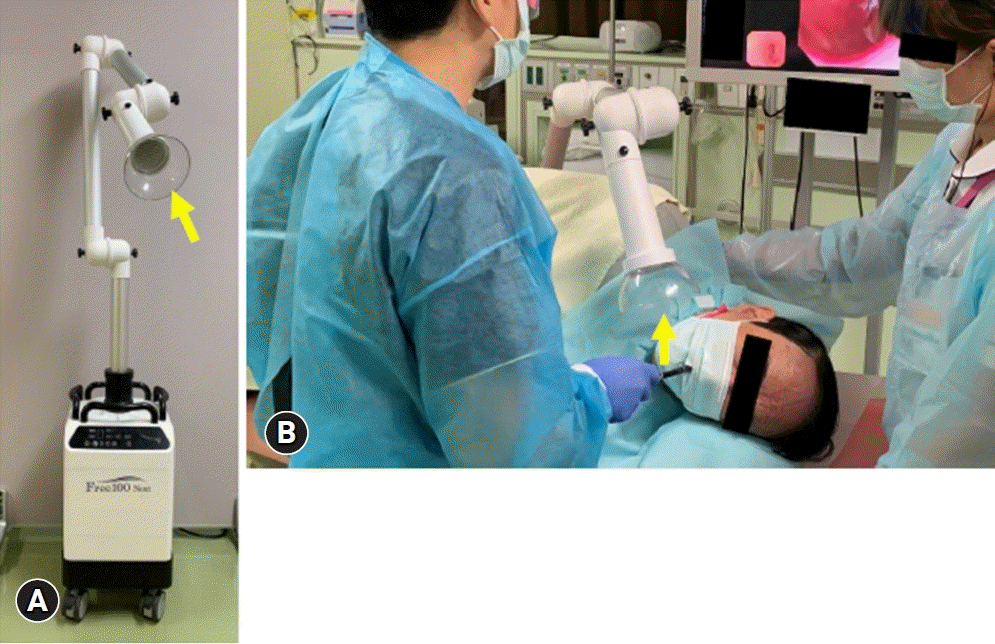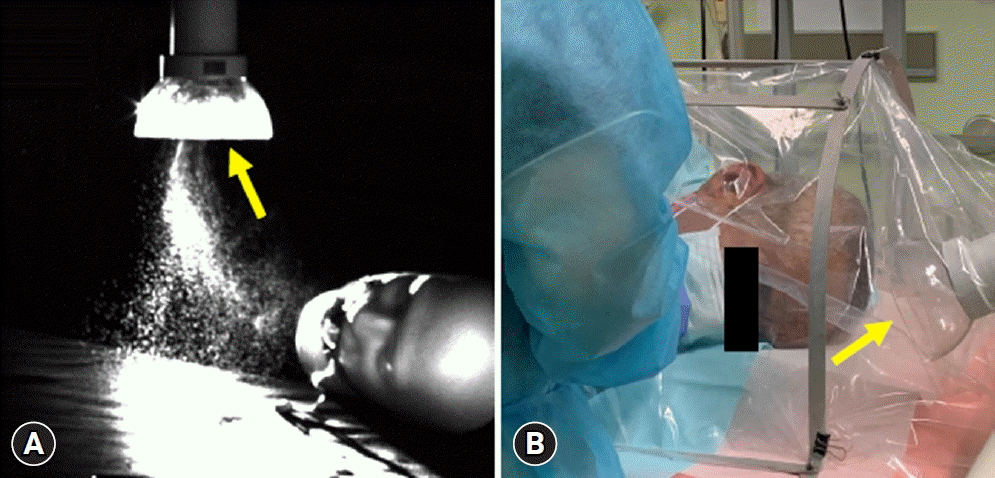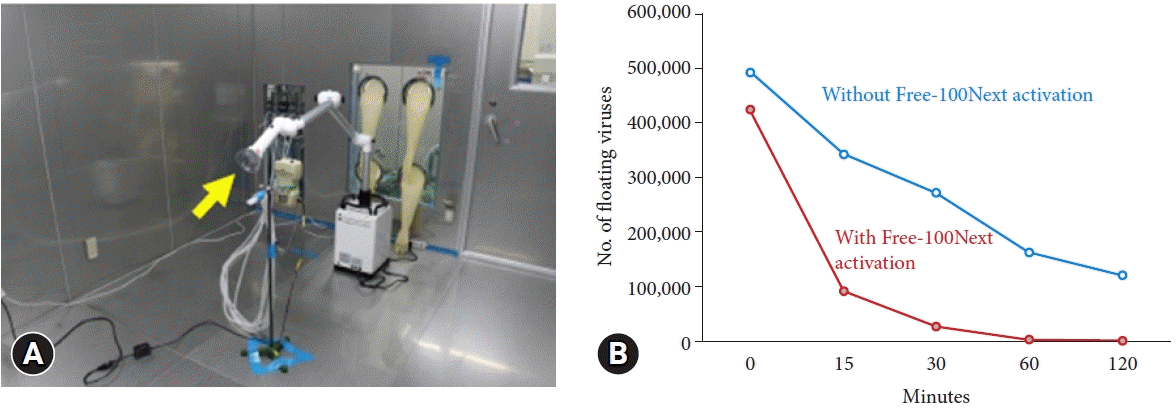This article has been
cited by other articles in ScienceCentral.
During the coronavirus disease 2019 (COVID-19) pandemic, peroral gastrointestinal (GI) endoscopy is considered a high-risk procedure for possible viral transmission. Several devices have been developed to prevent or remove aerosol droplets, such as masks and box-type droplet prevention devices.
1-
3 However, in the case of masks, aerosol droplets arising during scope insertion cannot be completely prevented. In addition, the box-type droplet prevention device can keep aerosol from the patient's mouth inside the box; however, upon removal of the box, the aerosols spread into the air, which is considered a problem.
4 A transportable high-flow extractor (Free-100M; Forest-One Co., Tokyo, Japan), which has been used in the dental field, has been reported to be used for aerosol droplet control in the medical field.
5 However, Free-100M has a large body and vacuum cup, as well as noise generated while vacuuming. Therefore, Free-100Next (Forest-One Co.) was developed as an improved version of Free-100M, as a novel transportable high-flow extractor. Free-100Next has a smaller body than Free-100M, and the vacuum cup is also smaller, with a diameter of 12 cm (
Fig. 1A). The noise volume while vacuuming was also reduced by approximately 20% compared to the Free-100M. In addition, Free-100Next is equipped with a special filter called the ultra-low particulate air (ULPA) filter. This filter is guaranteed by the Japanese Industrial Standards to be able to trap more than 99.9995% of the particles with a diameter of 0.15 µm. Therefore, by using Free-100Next, more than 99.9% of the viruses are trapped by the ULPA filter, and the air used for suction escapes through the exhaust port of Free-100Next. Since ULPA filter is removable, it can be disposed after use with one patient and applying a new filter for the next patient of so that no COVID-19 remains in Free-100Next. Therefore, we believe that this device is suitable for GI endoscopy (
Fig. 1B).
 | Fig. 1.The appearance of Free-100Next (Forest-One Co., Tokyo, Japan). (A) An overall view of Free-100Next. The yellow arrow indicates the vacuuming part. (B) A scene of clinical practice wherein Free-100Next is used during upper gastrointestinal endoscopy. The vacuuming part (yellow arrows) is positioned near the mouth of the patient. 
|
As proof of the efficacy of Free-100Next, an experiment using a mannequin showed whether Free-100Next can capture sprayed pseudo-saliva from the oral cavity of a mannequin (
Fig. 2A). The vacuum power of Free-100Next can be set to nine levels from level 1 to level 9. As shown in the experimental video, the pseudo-saliva was successfully captured even at level 3 and was even more reliably captured at level 9 (
Supplementary Video 1).
 | Fig. 2.The vacuuming effect of Free-100Next (Forest-One Co., Tokyo, Japan). and its use with a box-type droplet prevention device. (A) The experiment was conducted in a dark room to verify the vacuuming effect of Free-100Next on pseudo-saliva using a mannequin. Pseudo-saliva was successfully captured using the Free-100Next. (B) Free-100Next was used with a box-type droplet prevention device. During the upper gastrointestinal endoscopy, Free-100Next was placed inside the AP Cover (ABIS Corp., Hyogo, Japan) from the patient’s head. Yellow arrows indicate the vacuuming parts in the Free-100Next. 
|
However, fast-discharging aerosol droplets may not be completely captured by the Free-100Next. Therefore, it is best to use Free-100Next in conjunction with a box-type droplet prevention device (
Fig. 2B,
Supplementary Video 2). Most of the aerosols from the patient’s mouth were captured by Free-100Next, while the rest remained in the box. Free-100Next captured the aerosols remaining in the box.
To prove the vacuuming effect of Free-100Next, we conducted another experiment in which 0.025-µm-sized viruses (the size of SARS-CoV-2 is 0.1 µm) were circulated into a closed space of 25 m
3, and Free-100Next was activated to capture viral particles (
Fig. 3A). This experiment was performed at the Kitasato Research Center for Environmental Science (Kanagawa, Japan) because the experiment could not be performed in an endoscopy room. Compressed air was supplied from a compressor to the nebulizer containing the viral solution, and the viral solution was sprayed into the closed space at 0.2 mL/min for 10 minutes to float the virus. Subsequently, Free-100Next placed in the center of the closed space was set to level 9 for 60 minutes of continuous vacuuming of the virus. An impinger that collects the floating virus was fixed 50 cm below the Free-100Next. The number of airborne viruses was calculated from the liquid collected from the impinger. Similarly, as a control group, the number of floating viruses was calculated using the same method when Free-100Next was not used. The number of floating viruses in the space decreased by 60% after 15 minutes, 84% after 30 minutes, and 97% after 60 minutes, compared to the non-activation of Free-100Next. As a result, the number of floating viruses in the space dramatically decreased compared to that of the control (
Fig. 3B). Therefore, in actual GI endoscopic practice, the risk of aerosol diffusion into the endoscopy room would be reduced not only during endoscopy, but also when the box-type droplet prevention device is removed.
 | Fig. 3.An experiment to prove the ability of Free-100Next (Forest-One Co., Tokyo, Japan). (A) An experiment was conducted to determine the ability of Free-100Next to capture externally injected viruses in a closed space of 25 m3 using a control without Free-100Next to verify the reduction in the number of viruses in the space over time. The yellow arrow indicates the vacuumed part of Free-100Next. (B) The number of floating viruses in the space decreased by 60% after 15 minutes, 84% after 30 minutes, and 97% after 60 minutes, compared to the non-activation of Free-100Next. The blue line shows the changes in the number of floating viruses in the closed space, where the Free-100Next is activated. The red line indicates the same situation without Free-100Next activation. 
|
The Free-100Next, a novel transportable high-flow extractor, has certain limitations. First, Free-100Next alone cannot completely suppress aerosol droplets during GI endoscopy. Therefore, it is necessary to use masks and box-type droplet prevention devices. Second, it is costly. However, in the current situation where the novel coronavirus infection is not yet under control, the number of patients with COVID-19 necessitating GI endoscopy may increase in the future. Therefore, considering the high cost of COVID-19 treatment, we believe that Free-100Next will contribute to infection control. In conclusion, Free-100Next is useful for COVID-19 prophylaxis during an endoscopic procedure.







 PDF
PDF Citation
Citation Print
Print




 XML Download
XML Download